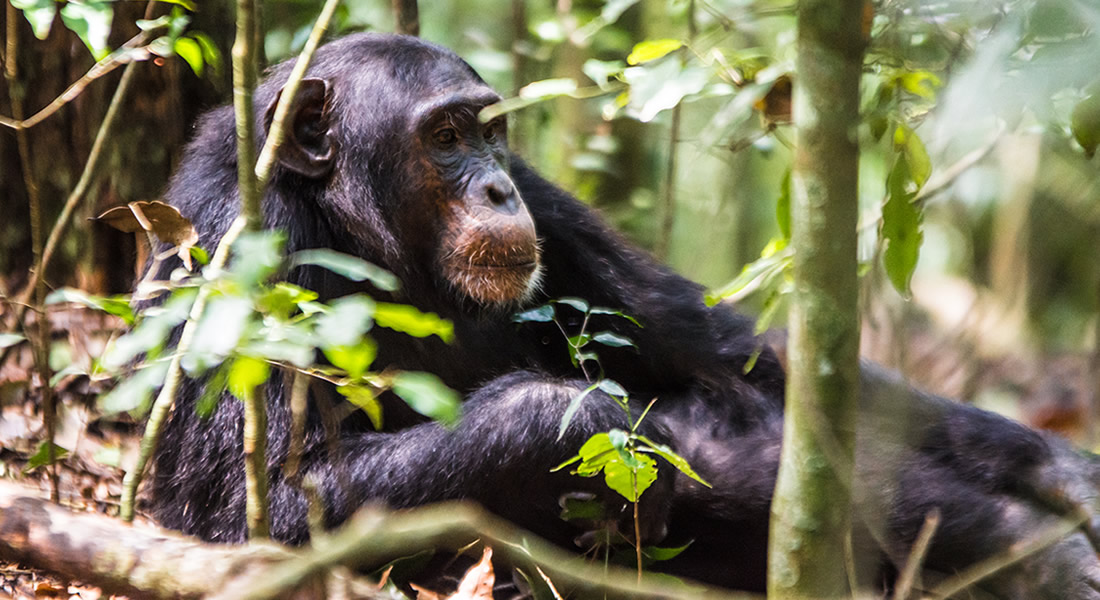Western Uganda is home to the Kibale Forest National Park, which spans the Kabarole and Kamwenge districts. The Park is home to 13 primate species, the largest number in East Africa, including around 5000 chimpanzees. The Kibale National Park is located over a region of around 795 square kilometres, at an elevation of between 1,100 metres (3,600 feet) and 1,600 metres (5,200 feet). Through activities like chimpanzee trekking, hiking, bicycling, caving, Crater Lake hikes, cultural visits, and Bigodi wetlands refuge, which is home to primates, birds, and mammals, you may explore a world beyond savannas and dry plains.

Wildlife.
Chances of seeing chimpanzees in their natural habitat are above 90%, although they are not guaranteed. This area is famous for its chimpanzees, who are the most visible. The most common animals are the black-and-white colobus, red-tailed monkey, and blue monkey; other primates include the olive baboon, grey-cheeked mangabey, bush baby, and potato. There are also a number of species of nocturnal primates, such as potato, Demidov’s tiny galago, and eastern needle-clawed bush babies. The swampy regions are where you may find the highly specialised sitatunga antelope. African buffalo, red and blue duikers, bushbucks, sitatungas, bush pigs, gigantic forest hogs, common warthogs, and other terrestrial animals may all be found in Kibale National Park. Leopards, African golden cats, duiker, a variety of mongooses, and two kinds of otters are among the carnivores that live there.
Chimpanzee Tracking in Kibale Forest National Park.
The morning and afternoon sessions of chimpanzee trekking in Kibale National Park both depart from the Kanyanchu Visitor Centre. The most sought-after primate by tourists, the chimpanzee trekking in Kibale National Park is an enriching experience in Uganda and is very rewarding. However, you should keep an eye out for the black and white colobus, red-tailed monkey, or the grey-cheeked mangabey. Your guides will be able to show you pittas, various bird species, and information on the customs associated with the plant species found in the forest. A party of six persons can take this stroll. Booking in advance is crucial, especially during Peak Sea.
You could see additional primates than chimpanzees throughout your chimpanzee tracking adventure, as well as some other animals like forest elephants, duikers, or buffaloes if you’re lucky. Chimpanzees can be seen occupied with fig tree eating, or you may run across them on the ground. Chimp tracking allows you the chance to observe chimps in their natural environment as they are busy nursing, grooming and in some cases, reproducing. You will also get the chance to climb and see various tree types. There are several species of butterflies in the park, and you may see them.
Birding in Kibale Forest.
About 325 different bird species may be seen at Kibale National Park, including the Black-capped Apalis, Blue-headed Sunbird, Collared Apalis, Purple-breasted Sunbird, and many others. Along with the six other native species that may be counted in the Albertine Rift region, they are the dark Crimsonwing, Black-capped Apalis, Blue-headed Sunbird, Collared Apalis, Red-Faced Woodland Warbler, and Purple-breasted Sunbird.
One of the best things to do in Kibale Forest National Park is go bird watching. Usually, this is done at Bigodi Wetland Sanctuary, a wonderful project for community development near Kibale National Park in Magombe Swamp. Bird species within the Sanctuary include the Black-crowned Waxbill, White-spotted Flufftail, White-breasted Negrofinch, Yellow-spotted Barbet, Black Bishop, Hairy-breasted Barbet, Bocage’s Bush-shrike, Yellow-billed Barbet, Brown-crowned Tchagra, Black & white Shrike-flycatcher, Western Nicator, and more. These birds can be easily spotted on any of the guided tours along the boardwalk trail or from Excellent Sunbird, Brown-throated Wattle-eye, Grey-winged Robin-chat, etc.
Guided Nature Walks
This is the most appealing aspect of visiting Kibale Forest National Park. Hiking and nature walks are two of the most satisfying activities to undertake both inside the park and in the area around it. You may go on a walk by following the route that traverses Kibale Park’s whole length. There are several locations where you may go for a day walk. Hiking provides you the chance to observe a variety of environments as you pass through forests, rivers, wetlands, and grasslands. The Bigodi Swamp is the most well-known swamp in the vicinity of Kibale. You get the chance to explore your life via the chimpanzee habituation experience.
Amabeere Ga Nyina’mwiru Caves
Amabeere Ga Nyina’mwiru Caves are one of the great caverns with a lot of natural wonders and cultural stories associated with them that will change you.
Visit Nakayima Witch’s Tree, a traditional religious and cultural place that is situated on top of a hill along the route to and from Kibale National Park. It is most famous for being the Witch’s Tree because it offers a wonderfully lovely view.
A trip to the crater lakes is worthwhile because it takes almost three hours and takes you through communities and tea plantations. Once you reach the top, you can appreciate the stunning scenery that surrounds the lovely crater lakes near Kibale National Park.
Accommodation Facilities in Kibale Forest National Park
Ndali Lodge, Primate Lodge, Crater Safari Lodge, Kyaninga Lodge, and Papaya Lake Lodge are just a few of the luxurious, first-rate lodging options available in the park. A mountain of the moon hotel, the chimpanzee forest guests home, the chimp nest, and Kibale forest camp are examples of mid-range lodgings that provide excellent service for tourists. Customers may also find affordable lodging that suits their needs at places like the Rwenzori View Guest House, the Nkuruba Nature Reserve, the Community Campground, Nyinabulitwa Country Resort, and the Safari Resort.
Best time to visit
The optimum time to follow chimpanzees is during the dry seasons (June to July and December to February). The park is open all year round, however in times of severe rain, the paths may be slippery and the whole experience may suffer.
